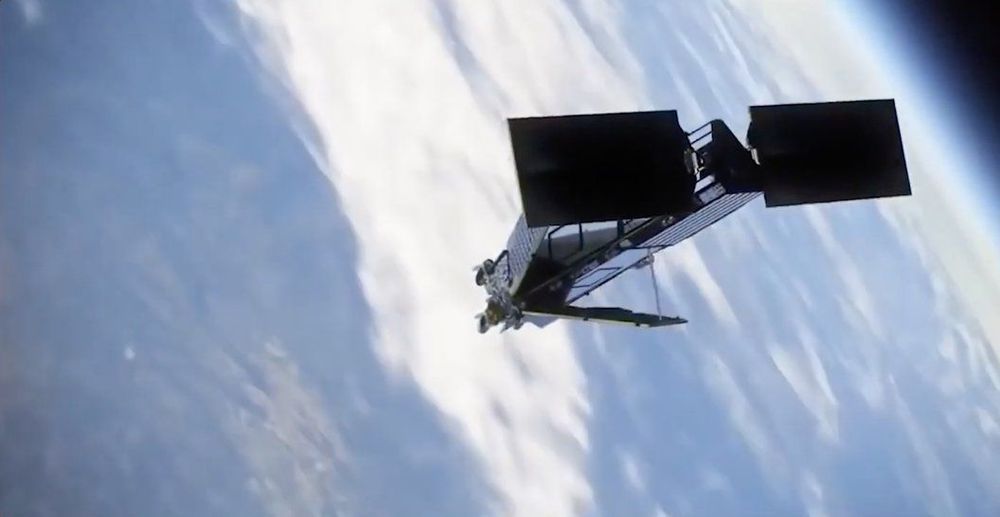Zero Zero Robotics has publically released its latest product, the V-Coptr Falcon, a v-shaped bi-copter. The drone can achieve a flight time of 50 minutes thanks to its two motors, which are attached via tilting arms. The V-Coptr Falcon also has a 4K 3-axis stabilized camera, obstacle avoidance, and a 7km transmission distance.
Get the latest international news and world events from around the world.
On This Day in Space! Dec. 30, 1930: 1st Photo of the Curvature of the Earth
On Dec. 30, 1930, the first-ever photo of the Earth’s curvature was taken.
This photo was taken by Lieutenant Colonel Albert William Stevens, who was an officer in the U.S. Army Air Corps and an aerial photographer. He also happened to be a balloonist, and he once broke a world record for a high-altitude balloon flight. Stevens took this photo while flying in a balloon over South Dakota.
He used infrared-sensitive film that worked well for long-distance aerial shots in which the subject was obscured by things like haze. The mountains he was photographing were more than 300 miles away, and he couldn’t see them with his own eyes. But his camera was sensitive enough! The photo was the first visual proof that our planet is, in fact, round.

Chip-to-chip quantum teleportation and multi-photon entanglement in silicon
Integrated optics provides a versatile platform for quantum information processing and transceiving with photons1,2,3,4,5,6,7,8. The implementation of quantum protocols requires the capability to generate multiple high-quality single photons and process photons with multiple high-fidelity operators9,10,11. However, previous experimental demonstrations were faced by major challenges in realizing sufficiently high-quality multi-photon sources and multi-qubit operators in a single integrated system4,5,6,7,8, and fully chip-based implementations of multi-qubit quantum tasks remain a significant challenge1,2,3. Here, we report the demonstration of chip-to-chip quantum teleportation and genuine multipartite entanglement, the core functionalities in quantum technologies, on silicon-photonic circuitry. Four single photons with high purity and indistinguishablity are produced in an array of microresonator sources, without requiring any spectral filtering. Up to four qubits are processed in a reprogrammable linear-optic quantum circuit that facilitates Bell projection and fusion operation. The generation, processing, transceiving and measurement of multi-photon multi-qubit states are all achieved in micrometre-scale silicon chips, fabricated by the complementary metal–oxide–semiconductor process. Our work lays the groundwork for large-scale integrated photonic quantum technologies for communications and computations.

Why Solitary Confinement Is The Worst Kind Of Psychological Torture
There may be as many as 80,000 American prisoners currently locked-up in a SHU, or segregated housing unit. Solitary confinement in a SHU can cause irreversible psychological effects in as little as 15 days. Here’s what social isolation does to your brain, and why it should be considered torture.
There’s no universal definition for solitary confinement, but the United Nations describes it as any regime where an inmate is held in isolation from others, except guards, for at least 22 hours a day. Some jurisdictions allow prisoners out of their cells for one hour of solitary exercise each day. But meaningful contact with others is typically reduced to a bare minimum. Prisoners are also intentionally deprived of stimulus; available stimuli and the fleetingly rare social contacts are rarely chosen by the prisoners, and are are typically monotonous and inconsiderate of their needs.


Iridium would pay to deorbit its 30 defunct satellites — for the right price
WASHINGTON — Iridium Communications completed disposal of the last of its 65 working legacy satellites Dec. 28, while leaving open the possibility of paying an active-debris-removal company to deorbit 30 that failed in the decades since the operator deployed its first-generation constellation.
McLean, Virginia-based Iridium started deorbiting its first constellation, built by Motorola and Lockheed Martin, in 2017, as it replaced them with second-generation satellites from Thales Alenia Space.
Of the 95 satellites launched between 1997 and 2002, 30 malfunctioned and remain stuck in low Earth orbit, according to Jonathan McDowell, an astronomer at the Harvard-Smithsonian Center for Astrophysics.

Betelguese, one of the brightest stars in the sky, might be on the brink of explosion
INDIANAPOLIS (WTHR) — One of the sky’s brightest stars has been acting a little weird recently.
Betelgeuse, a bright star in the constellation Orion, has been rapidly dimming since the beginning of December. It’s already dimmed by a factor of two, according to the Independent, which makes the change visible to the naked eye. Betelgeuse was once the ninth brightest star in our sky, but after its dimming it doesn’t even break the top 20 anymore, according to the Washington Post.
The star is known as a “variable” star, which means it’s characterized by cycles of brightening and dimming. However, scientists have never recorded it dimming so fast. Astronomers Villanova University say this is an all time low in brightness for the star.

How can we live longer?
5 European startups extending our lifespans ~ via EU-Startups #perpetuallife
How can we live longer? 5 European startups extending our lifespans
How can we live longer? How do we live healthily to extend our lifespans? How do we feel younger than our age? These are among the many questions scientists have been trying to answer about aging.

